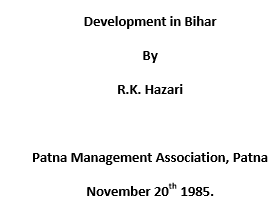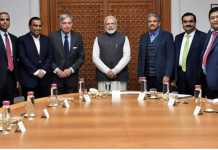Edited transcript of a Talk at the Patna Management Association, Patna
Mr. President, Gentlemen
I welcome the opportunity that you have provided to visit Patna after nearly a decade
I have been involved in the development problems of the eastern and north-eastern regions in the past and I like to be Involved in them now also. I have some affinity with the problems of this area because I feel that unless these problems are tackled the future of the entire country is at stake. A large proportion of the population of the country is located In this region. While the Ganga is associated in the public mind with holiness and sanctity it is also unfortunately associated with a heavy concentration of poverty. It is mainly the poverty in the Ganga valley which makes the country poor. If one were to take India outside the larger Ganga valley our Indicators of development would appear to be fairly respectable. It is because of the problems of this area that nearly all our development indicators get pushed down. It could not be that there is something entirely wrong either with the land or with the people of this region. There was a time, no doubt very long ago when this region was prosperous, Kalinga was perhaps the oldest known empire in the country. In later times as more people settled in the valley the regions that are now North Bihar, Eastern U.P. and parts of eastern Bengal were known for their fertility, their handicrafts and their exports. From Kalinga itself we have references to Bali yatra. There are copious records – not so much in this country as in South East Asia – of the very close trade links that this part of the world had with that part.
We also have evidence, which finds support in the temples and the sculptures that we see of large economic surpluses generated from agriculture and from trade. The construction of huge temples the maintenance of huge monastries or the existence of universities like Nalanda was possible because of prosperity in the land.
There was certainly a decline later on, first in post-Maurya [Maurya period is from 321 BC to 185 BC] times and then the post-Gupta [Gupta period 320 to 550 CE] times. The area was still prosperous till the time of Aurangzeb [reigned from 1658-1707] and even thereafter at least to justify the frequent military campaigns waged In Bihar. It is no use blaming the East India Company alone for what happened thereafter. To the ravages of time were added the ravages of new technology and the frequent raids of marauders of various kinds.
What are the reasons which can be identified as being responsible for inadequate growth In the territories east of Lucknow or more specifically east of Varanasi I think It Is useful to make these comparisons within the country rather than countries, why for instance had Punjab progressed so much, at least till the recent rounds of troubles and why haven’t the regions east of Varanasi done well?
Till roughly the end of the last century most of Punjab was a desert. Canal irrigation facilities of course gave a great boost. While there is plenty of water in the east it has not been properly utilised Where it has been utilised for canal irrigation It has led to water-logging. Eastern canals were left unlined for a variety of reasons. While the construction of new canals or embankments always appears attractive and fashionable, very little attention is paid to the maintenance of the existing canal system and to drainage which is necessary complement to irrigation.
Soil erosion and deforestation have made floods more frequent and damaging, though floods have been known since the beginning of history. If nothing could be done about floods – and we all know that flood protection is an extremely expensive and difficult exercise – the least that could have been done was to have more crops in the off-flood season, that is to say, to have more concentration on rabl crops rather than on kharif crops. Unfortunately no such effort has been undertaken consistently on any large scale. This would have required tube-well or dug-well irrigation. For instance, during the late sixties and early seventies, there was a successful effort at bamboo tube wells in north west Bihar. For a variety of reasons, nevertheless, since roughly the mid-seventies, there has been a leveling off of such efforts.
In agriculture, prosperity comes not so much from investment in the main crop, or what had been the main crop for some time, but In the growing of a second crop, and a third crop. This matter has been consistently neglected. It is not for me to say whether It is central neglect, or state neglect, or local neglect. Such effort does require integrated direction. It requires not only irrigation, but also a certain degree of awareness among the farmers, research on new seeds that would be responsive to irrigation and fertilizer, and which would be amenable to cultivation during the rabi season it requires more attention to the marketing of agricultural produce. Unlike Punjab, there are almost no mandis worth the name in the eastern region. Roads are extremely bad. Therefore, even If the farmers were to produce a lot more, either in kharif or in rabi, they cannot get the full benefit of their additional efforts.
Many people have commented upon the quality of government in these regions. There is no doubt that the quality of administration whether of the police or of the districts or of the agricultural departments or generally has not been comparable with that in the states which have made a fair lot of progress. Rather than beating our breasts vigorously about what is not there, one should focus attention on what are the things that can be done or what should be done. As in anything else, one has to start at the beginning. And that is with the educational institutions.
Since I myself am partially a product of Punjab University I may be pardoned If I refer to the fact that Punjab University was an extremely sound and healthy institution; If lot of people from Punjab have left their mark in the country since Independence, and continue to do so even now it is because of the very healthy crop of young men and women contributed by Punjab University. I covered not only Lahore and Amritsar and many other centres in undivided Punjab, but also the Agricultural College at Lyallpur [now called Faisalabad, in Pakistan] which is the nursery of agricultural development in Punjab.
Institutions have not been wholly lacking in the eastern region. On paper, there have been institutions in plenty and a few of them have an excellent record. Most of them have not worked as well as they should have. If any effort is to be made to preserve the quality of life and the quality of leadership and direction in these parts of the country, I would assert that the beginning has to be made with the quality of school and college education in all its aspects. They will have to be run a lot better. They will have to be freed from the factional and partisan considerations that appear to have ruled supreme. I do not mind disputes about the curriculum or even the medium of instruction. It is not as if good teachers are lacking – I am sure there must be plenty of good teachers in the enormous teeming population of this region but they have to teach not get involved In various other activites.
I would also say that one of the greatest deprivations that this region has suffered is the fact that after the 1857 mutiny, U.P. and Bihar were declared to be non-martial. The Bengal Amy of the East India Company was largely a Hindustani Army recruited from Avadh and the east; as a result of its making, recruitment to the Indian Army was transferred almost wholly to the north, west and the south. Deprivation of military recruitment in this area has been a far greater deprivation than has been generally appreciated. Heavy military recruitment in Punjab and the neighbouring areas of Rajasthan and Western U.P. gave the local people a stake in the country, a state in the established order. More than that it exposed the people to new needs and new ways of life. When they got accustomed during the First World War [1914-1918] to drinking tea and to wearing much better clothes and shoes than they would have in the villages when they went back, the least that they aimed at was to continue to have at least that standard of living. There was a certain consciousness of the need for growth and to work towards it what is more, the families concerned got a cash income in hand which was totally dependable. And after the boys retired from the army, they got cash pensions. Whatever might be said about the level of remuneration or pensions in the army, then or now, the receipt of a regular cash income in the hands of the rural people makes all the difference to their saving power. It is also an insurance against calamities. It also gives people a stake in investment in what is now called human resource development, namely, sending the boys to school and keeping them healthy so that they qualify for a higher category of prosperity in life.
The deprivation that the region has suffered because of the misadventure of the Bengal Army [in the mutiny of 1857] has stayed with the region for a long time. I am not tracing a link between army discipline and the indiscipline that is said to be rampant in this region. I think discipline is a much abused word. Discipline is a means to an objective, it is not an objective in itself. People must see the objective, then they feel the need for discipline. Had the need for an objective been more keenly felt, then the means to the objective would also have been appreciated more sharply. But the very low level of army recruitment and, till recently, till maybe a decade back, even recruitment to the BSF [Border Security Force] and CRP [Central Reserve Police], meant that there was an inadequate cash flow to the people who would have found employment in these large organised forces as a source of regular cash inflow. One can add to that when people have worked in the army, and now if you like, the paramilitary forces, they pick up the habit of organised working. They get accustomed to working together. And as there has been more mechanisation over the years they also get accustomed to handling machines, equipment and tools. This deprivation has been a fundamental source of inadequacy at the human level at the organised human level, particularly for a segment of the population to which recruitment into the civil services is not really feasible, because they do not have the educational levels to get into them.
I would also say that, over the last 80 to 100 years, while the rest of the country has been changing over to other means of transport, the eastern region which had a unique advantage in river transport, has been progressively dislocating this facility and hardly replacing it with any other. The rivers have been silting up or, so much water has been taken into canals, that they do not have adequate depth for the vessels that now tend to be larger. The jetties, which are necessary for river transport, have been disappearing into the silt. We have not really tried to modernise our river transport on which this region has always depended, and probably will have to depend.
Building roads in this part of the country is notoriously difficult. Why this should remain so is beyond my understanding – I am not a technical person. True, there is not enough stone in most parts of Ganga valley (but Chhota Nagpur has plenty of stone and still its roads are horrid), but I still don’t see why roads must be paved with brick, or, that they should have such poor asphalt on then. How overloaded trucks run at all on your roads and culverts is a mystery to me. New technology is required for the construction and maintenance but it would still be necessary to revive river transport.
I have mentioned these considerations because, when comparisons are made, say, between Punjabis and Biharis or Purbias [residents mainly Rajputs and some Brahmins of Allahabad, Avadh and Bihar], the discussion tends to assume ethnic dimensions allegedly arising from congenital advantages or disadvantages. In Assam, Nagaland and Manipur, the Biharis are known to be hard workers. The Bihari in Mauritius or Fiji or the Gorakhpuri in Thailand is known for his hard work.
I may draw your attention to certain other factors concerned with social reforms and other societal considerations. It could be true to say that Punjab had the great advantage of the Sikh reform movement and, then, the Arya Samaj. Their importance tends to be down rated because the latter gets mixed up with religion per so The main benefit that accrued from the teachings of the Sikh gurus and the spread of Sikhism, followed soon thereafter by the spread of the Arya Samaj for at least 50 years in Punjab between the 1880s and the 1930s, was not egalitarian in economic terms, but that they laid the ground work for a more homogenous social outlook – human beings came to be accepted as human beings, and it would not be at all true to say that caste consciousness disappeared in Punjab, at least some of the worst features were greatly checked by the homogenising societal changed which were brought about by the Sikh and Arya Samaj reform movements. They weakened superstition and at least brought people together for common worship which is a serious bottleneck among Hindus. They also persuaded people to mix relatively freely with each other and to have at least some common objectives. There has been almost no such reform throughout most of U.P., Bihar, Orlssa and Bengal. Bengal did have a Chaitanya reform movement, but it was more of a religious movement and the Brahmo Samaj remained elitist they never percolated to all sections of society I do not see how any firm basis of progress can be laid unless there is less caste consciousness and greater emotional readiness to accept other human beings not as economic equals but at least as human equals, without that, it would be extremely difficult to get rid of even the negative industrial labour unionism that you have in this part of the country. While we very much deplore, quite rightly, the militant unions here which prevent any discipline, one has also to accept that this indiscipline is an outpouring, a reaction against many of the old modes of behaviour associated in the mind with those who are at the top of the pyramid.
There is another controversial factor and that is the question of land reform, zamindarl abolition, in fact, never took place in Bihar for a variety of reasons. But that is not the only feature of land reform. The benefits of Zamindari abolition have been overemphasized in post-independence history it would be true to say that land records here are extremely unsatisfactory And that makes it extremely difficult either to have security of land tenure or to have permanent investment in the land. It also becomes extremely difficult to have consolidation of holdings. This is a very marked difference between the situation in Bihar and that in Punjab. Very well, one cannot ask for the moon. If it is politically not feasible, whatever the reasons to have the land reforms that were undertaken in other states in the late 40s and the 50s, namely, effective abolition of zamlndari and giving of land to the so-called tiller (which has not worked too well in most places let’s admit it) then what are the other reforms possible.
The little exposure that I had to financing of agriculture in Bihar In the 1970s indicated that the problem was not impossible It can be solved. What is required is more investment in the land, and a more equitable distribution of its benefits. The titles to land ownership are insuperable barriers, how about titles to land occupancy? what you require is a patta from the BDO or Tahsildar or equivalent to say that a man is in occupation of certain plots of land. On that basis, one can finance investment in land improvement and supply of associated inputs, giving greater access to credit and marketing which, in my biased opinion is as important as access to the ownership of land. If you cannot get over the hump, you can outflank it. Unfortunately, our Leftists and other reformers are about as traditional as anybody else; everybody seems to argue in the sane rut as 30, 40, 60 years back. Ownership of land is not the only thing that matter in land reforms. Land is not the only productive asset that matters. The other inputs now are at least as important. If not more important. What is required, therefore, is to supply the other inputs, with some via media about the land as a matter of compromise. Between 1970 and 1973, this strategy did produce some results in parts of the old undivided districts of Shahabad, Gaya, Champaran, Saran and a small part of Muzaffarpur.
Politics is, after all, the art of the possible. If one set of actions is not possible, let’s proceed with another set of actions with less controversy and less confrontation.














